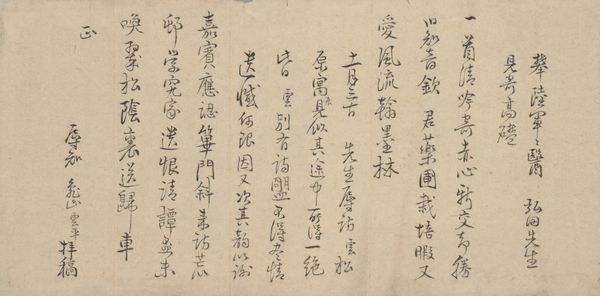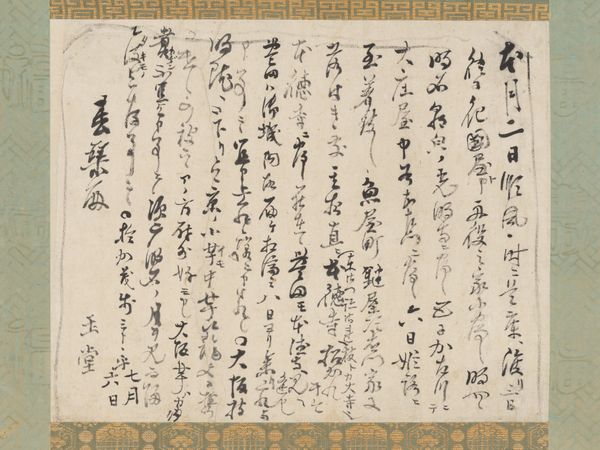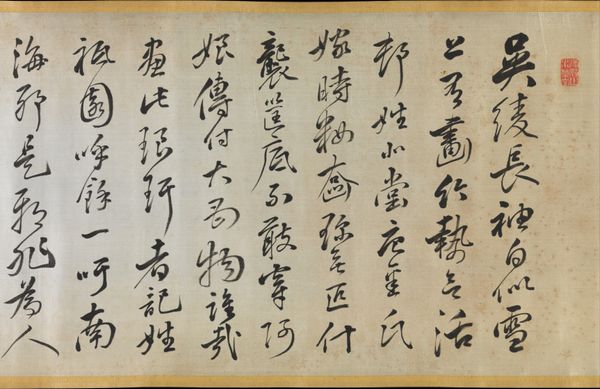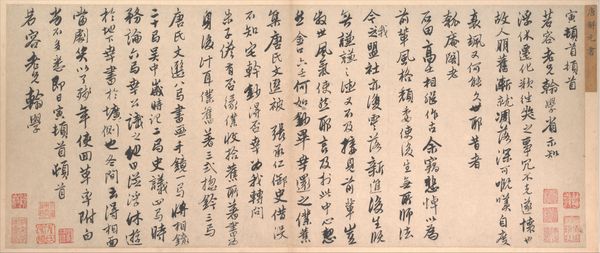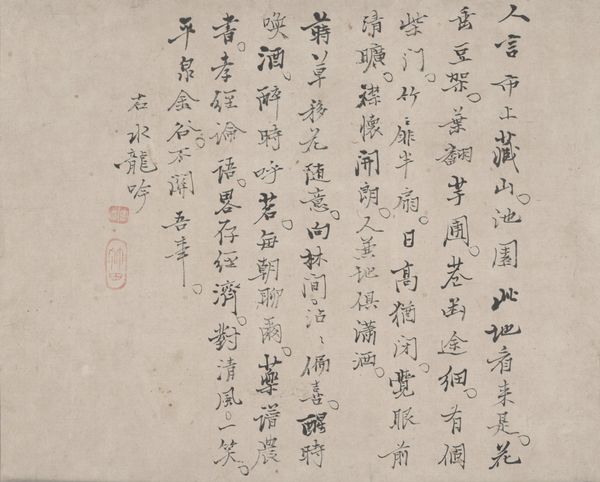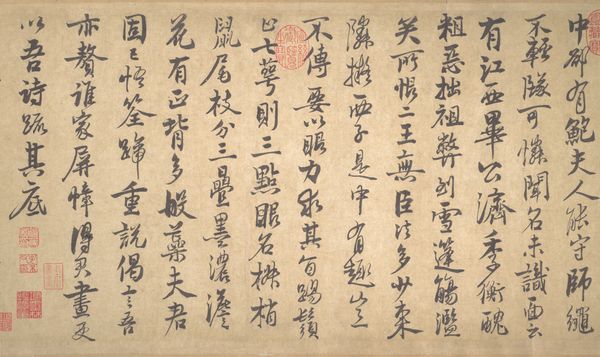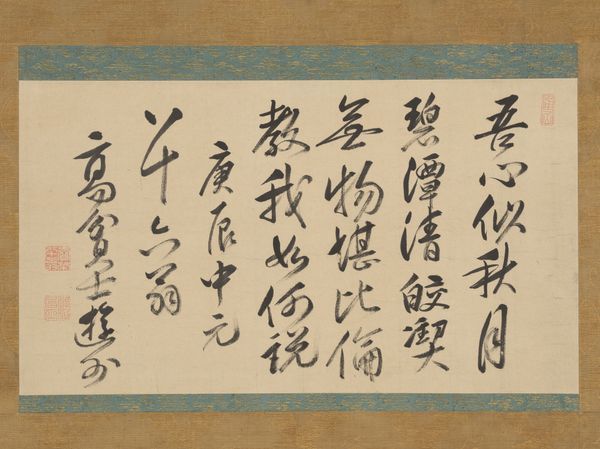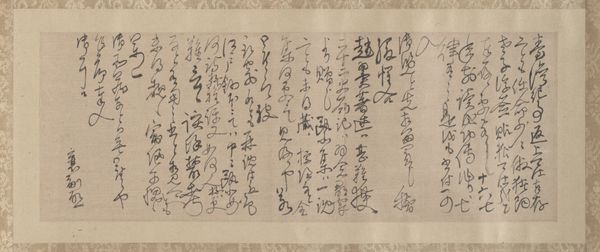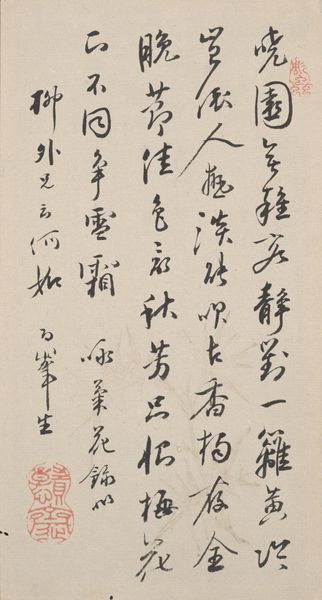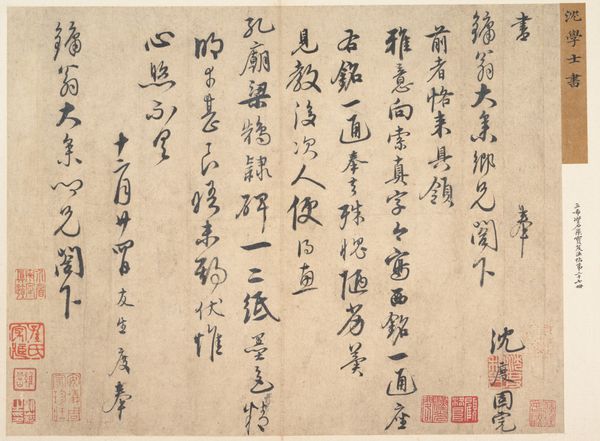
drawing, paper, ink-on-paper, hanging-scroll, ink
#
drawing
#
hand-lettering
#
asian-art
#
hand drawn type
#
hand lettering
#
japan
#
paper
#
ink-on-paper
#
hanging-scroll
#
ink
#
hand-written
#
hand-drawn typeface
#
fading type
#
stylized text
#
thick font
#
handwritten font
#
calligraphy
#
small lettering
Dimensions: 14 1/4 × 25 13/16 in. (36.2 × 65.56 cm) (image)51 7/8 × 29 3/4 in. (131.76 × 75.57 cm) (without roller)
Copyright: Public Domain
Curator: This artwork, entitled "On the Calligraphy of Emperor Saga," is attributed to Ryū Kōbi and possibly dates back to 1783. It's executed in ink on paper, presented as a hanging scroll, and currently resides in the collection of the Minneapolis Institute of Art. Editor: It strikes me as delicate and incredibly poised. The controlled lines and measured spacing evoke a sense of serenity, almost meditative, despite being densely packed with text. Curator: Indeed. If we examine the calligraphic style, we notice a disciplined flow achieved through variations in stroke weight and the controlled use of negative space. The composition balances legibility with artistic expression; it's less about conveying easily readable text and more about the visual rhythm created by the characters themselves. Editor: I am particularly drawn to the lower left corner, to the two red seals placed there. Red symbolizes luck and joy, I'd hazard. Are these seals important additions? Are they signatures of appreciation or confirmation? Curator: They are significant. Such seals authenticate and often contextualize the work, attributing authorship and perhaps recording subsequent ownership or critical appreciation over the centuries. Their placement creates a counterpoint to the dark calligraphy, providing a focal point. Editor: What interests me are these continuities: Emperor Saga’s script from centuries earlier still admired, replicated, analyzed! Even the ink and paper carry meaning. It's a testament to the lasting power of artistic heritage and cultural memory. Curator: Agreed, the materiality, the very 'thingness' of ink and paper supports a centuries-long dialogue. The fading of the ink itself tells a story of preservation and endurance, reminding us of the artwork’s own history and its connection to a bygone era. Editor: It reminds me that cultural expressions aren't frozen. That people still admire and seek meaning from past artists through their individual memories and traditions. Curator: Absolutely. It provides, too, insight into artistic disciplines across generations! A testament to Kōbi's keenness. Editor: Precisely. For me, it's this interweaving of cultural memory and delicate execution that elevates this calligraphic scroll from mere text to a profound visual poem.
Comments
minneapolisinstituteofart almost 2 years ago
⋮
This text, written in 15 lines of standard script that was executed thinly and precisely, discusses how the Emperor Saga (r. 809–823) was the finest of the “Three Brushes” (Sanpitsu), a group of three famous calligraphers of the Heian period (794–1185). The author, Confucian scholar Ryū Kōbi, laments that it is so difficult to see his genuine works. 斯巻者 / 嵳峩天皇之聖茟而絶代之玉珍也 / 夫 天皇之於書也冢 / 大東三茟之最而糸古今山斗恁景御也 / 状世遠亗夐〇宸然之存干今者絶未之有 / 聞也矣述日公美讀盍簪録之曰 天皇哭 / 澄上人詩之宸茟一張蔵而在青遂王夜鳥 / 状〇今與新巻合〇可謂雙珠聮璧也豈不 / 奇耶豈小奇耶急斯巻我藩之夜庫韞 / 匱而蔵者有年矣今候好文之餘命臣公美 / 挙冩以上石屬諸不朽不無〇氣乎公美 / 雖老朽乎適遭斯時辱承斯命實々載之 / 一遇也輒爵躍敢従事干斯云
Join the conversation
Join millions of artists and users on Artera today and experience the ultimate creative platform.
